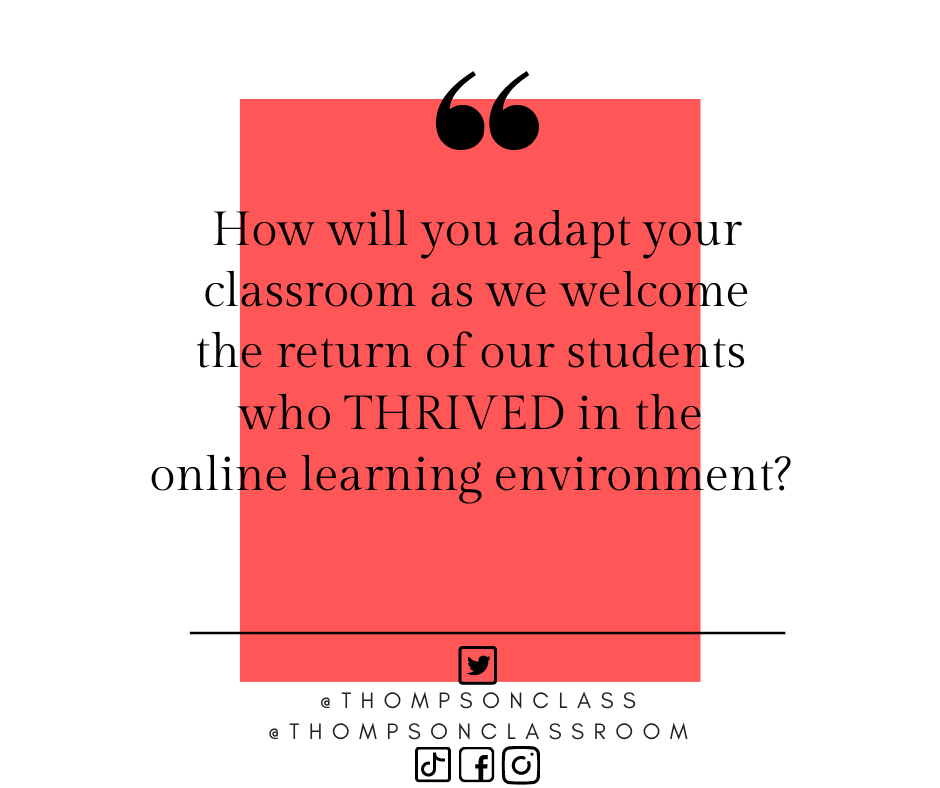Students Thriving Online

Every Monday I share a different ed tech quote on our Thompson Classroom social media pages for our staff to consider.
Here in Manitoba it has been a full week since we welcomed the vast majority of our students back to our buildings following a period of temporary remote learning which ended on January 15th. While we continue to have some of our learners enrolled in remote learning as a result of medical accommodations or logistical constraints, almost all of our learners are now attending in-person. While this has been celebrated by many stakeholders we can’t ignore that, for those with access, online learning has proven to be advantageous for particular subsets of learners.

Starting in the spring of 2020, during the provincial suspension of in-person classes, we began to hear anecdotes from families, educators, and students themselves about their preference for online instruction. For almost all of our learners, programming options outside of the traditional face-to-face environment had not been considered prior to this point.
Almost a full year later we now have a distinct group of learners who have identified that not only did they prefer online programming but they wish that they could continue with this route. While the future of online programming in Manitoba for K-12 remains to be seen I think we need to reflect on why this method works for some of our learners and how we can support them now that they are back in a face-to-face environment.
PLACE
Online programming allows the flexibility of being an active participant in your learning from the comfort of your own home. Students can be in their own bedrooms, sunrooms, outside (probably not in January), while on the road, from the hospital, etc. We have always had a demographic of students who missed school due to family trips, custodial changes, extracurriculars, medical leaves, etc. Now that access to programming transcends one specific location our students have consistent access to their education.
The way in which many of our educators have set up their courses involves the recording of content, synchronous time to discuss and work together, and independent exploration through a variety of activities. This provides students with the options to work through aspects of their programming on their own pace rather than working within the constraints of a traditional blocked schedule. This has proven to be advantageous for learners on both sides of this component: students can complete their work quickly and move onto another subject without having to wait on their classroom peers while others can take additional time to complete tasks with a pace with aligns with their needs.
PACE
CONTENT
It is common for rural schools to not offer a roboust slate of electives due to the logistical constraints of their small class sizes, remote locations, small staff pool, etc. As such, learners may feel that there can not find opportunities to explore topics that are relevant and meaningful to them. Online programming opens up a full suite of options for students to enroll in classes that align with their interests and long-term goals.
Online programming has also facilitated increased opportunities for students to explore content through a cross-curricular and project-based approach. Compared to a traditional subject-specific approach, this allows multiple avenues to be explored while reducing screen time and respecting bandwidth caps. For many of our students this approach has allowed for a deeper understanding of the content, increased ability to transfer, and higher engagement via student-lead project exploration.
Some elements of accessibility have already been discussed, such as learner ability to select their own place and pace. Other elements are built-in to the system itself such as:
- text-to-speech
- speech-to-text
- ability to pause/restart instruction as needed
- slow down or speed up recordings
- closed captioning
- screen/text/image colours
- text size
It is also important to note that online programming allows for these accommodations to be accessed and implemented outside of the view of the learner’s peers.
ACCESSIBILITY
If we look at this list it is evident that these are practices that are beneficial for all learners, regardless of if they are face-to-face or participating remotely. I encourage you to reflect on your own practice and see how these elements can be included purposefully into your instruction so that all students can find their personal success.